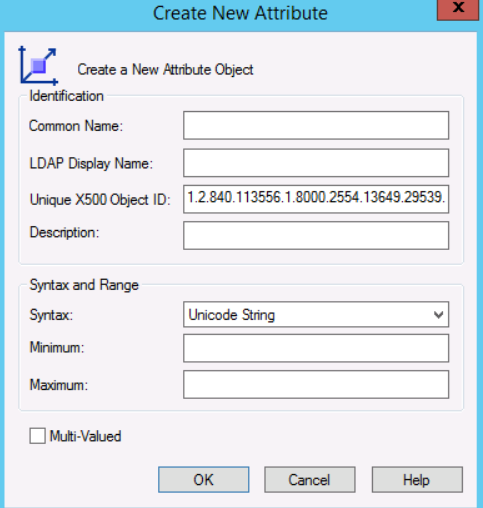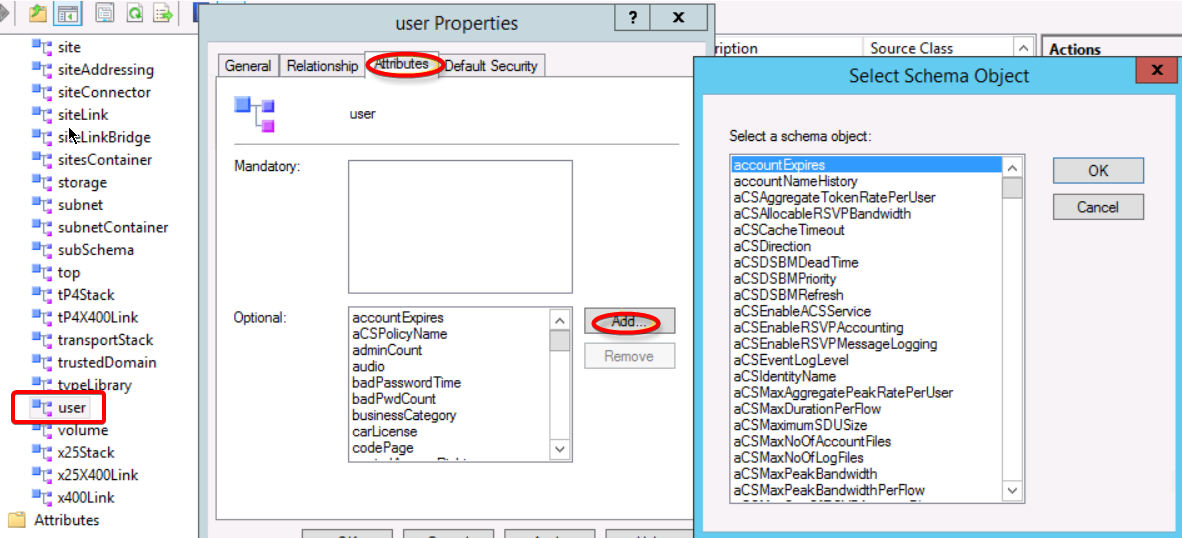In this article, we will see how to create an Active Directory custom attribute. All of the steps below are done on a domain controller.
- First, we need to Register the Schema DLL
Bring up an elevated command prompt and run the following command.
regsvr32 schmmgmt.dll
- Confirm that your account is added to the Schema Admins group. If you are not part of the group add yourself and sign out and sign back.
- Open MMC and add the Active Directory Schema

- Copy and save the text below into a VBS file. Call it “generate_oid.vbs”
| ============================================================================================================
‘ oidgen.vbs ‘ ‘ THIS CODE AND INFORMATION IS PROVIDED “AS IS” WITHOUT WARRANTY OF ANY KIND, EITHER EXPRESSED ‘ OR IMPLIED, INCLUDING BUT NOT LIMITED TO THE IMPLIED WARRANTIES OF MERCHANTABILITY AND/OR ‘ FITNESS FOR A PARTICULAR PURPOSE. ‘ ‘ Copyright (c) Microsoft Corporation. All rights reserved ‘ ‘ This script is not supported under any Microsoft standard support program or service. ‘ The script is provided AS IS without warranty of any kind. Microsoft further disclaims all ‘ implied warranties including, without limitation, any implied warranties of merchantability ‘ or of fitness for a particular purpose. The entire risk arising out of the use or performance ‘ of the scripts and documentation remains with you. In no event shall Microsoft, its authors, ‘ or anyone else involved in the creation, production, or delivery of the script be liable for ‘ any damages whatsoever (including, without limitation, damages for loss of business profits, ‘ business interruption, loss of business information, or other pecuniary loss) arising out of ‘ the use of or inability to use the script or documentation, even if Microsoft has been advised ‘ of the possibility of such damages. ‘ ———————————————————————- Function GenerateOID() ‘Initializing Variables Dim guidString, oidPrefix Dim guidPart0, guidPart1, guidPart2, guidPart3, guidPart4, guidPart5, guidPart6 Dim oidPart0, oidPart1, oidPart2, oidPart3, oidPart4, oidPart5, oidPart6 On Error Resume Next ‘Generate GUID Set TypeLib = CreateObject(“Scriptlet.TypeLib”) guidString = TypeLib.Guid ‘If no network card is available on the machine then generating GUID can result with an error. If Err.Number <> 0 Then Wscript.Echo “ERROR: Guid could not be generated, please ensure machine has a network card.” Err.Clear WScript.Quit End If ‘Stop Error Resume Next On Error GoTo 0 ‘The Microsoft OID Prefix used for the automated OID Generator oidPrefix = “1.2.840.113556.1.8000.2554” ‘Split GUID into 6 hexadecimal numbers guidPart0 = Trim(Mid(guidString, 2, 4)) guidPart1 = Trim(Mid(guidString, 6, 4)) guidPart2 = Trim(Mid(guidString, 11, 4)) guidPart3 = Trim(Mid(guidString, 16, 4)) guidPart4 = Trim(Mid(guidString, 21, 4)) guidPart5 = Trim(Mid(guidString, 26, 6)) guidPart6 = Trim(Mid(guidString, 32, 6)) ‘Convert the hexadecimal to decimal oidPart0 = CLng(“&H” & guidPart0) oidPart1 = CLng(“&H” & guidPart1) oidPart2 = CLng(“&H” & guidPart2) oidPart3 = CLng(“&H” & guidPart3) oidPart4 = CLng(“&H” & guidPart4) oidPart5 = CLng(“&H” & guidPart5) oidPart6 = CLng(“&H” & guidPart6) ‘Concatenate all the generated OIDs together with the assigned Microsoft prefix and return GenerateOID = oidPrefix & “.” & oidPart0 & “.” & oidPart1 & “.” & oidPart2 & “.” & oidPart3 & _ “.” & oidPart4 & “.” & oidPart5 & “.” & oidPart6 End Function Function WriteOIDToFile(oid) Set fsoObj = CreateObject(“Scripting.FileSystemObject”) outFile = “C:\temp\oid.txt” Set objFile = fsoObj.CreateTextFile(outFile, True) objFile.Write oid objFile.Close End Function newOID = GenerateOID WriteOIDToFile(newOID) ‘Output the resulted OID with best practice info Wscript.Echo “Your root OID is: ” & VBCRLF & newOID & VBCRLF & VBCRLF & VBCRLF & _ “And has been saved to oid.txt in the current directory. This prefix should be used to name your schema attributes and classes. For example: ” & _ “if your prefix is “”Microsoft””, you should name schema elements like “”microsoft-Employee-ShoeSize””. ” & _ “For more information on the prefix, view the Schema Naming Rules in the server ” & _ “Application Specification (http://www.microsoft.com/windowsserver2003/partners/isvs/appspec.mspx).” & _ VBCRLF & VBCRLF & _ “You can create subsequent OIDs for new schema classes and attributes by appending a .X to the OID where X may ” & _ “be any number that you choose. A common schema extension scheme generally uses the following structure:” & VBCRLF & _ “If your assigned OID was: 1.2.840.113556.1.8000.2554.999999” & VBCRLF & VBCRLF & _ “then classes could be under: 1.2.840.113556.1.8000.2554.999999.1 ” & VBCRLF & _ “which makes the first class OID: 1.2.840.113556.1.8000.2554.999999.1.1” & VBCRLF & _ “the second class OID: 1.2.840.113556.1.8000.2554.999999.1.2 etc…” & VBCRLF & VBCRLF & _ “Using this example attributes could be under: 1.2.840.113556.1.8000.2554.999999.2 ” & VBCRLF & _ “which makes the first attribute OID: 1.2.840.113556.1.8000.2554.999999.2.1 ” & VBCRLF & _ “the second attribute OID: 1.2.840.113556.1.8000.2554.999999.2.2 etc…” & VBCRLF & VBCRLF & _ “Here are some other useful links regarding AD schema:” & VBCRLF & _ “Understanding AD Schema” & VBCRLF & _ “http://technet2.microsoft.com/WindowsServer/en/Library/b7b5b74f-e6df-42f6-a928-e52979a512011033.mspx ” & _ VBCRLF & VBCRLF & _ “Developer documentation on AD Schema:” & VBCRLF & _ “http://msdn2.microsoft.com/en-us/library/ms675085.aspx ” & VBCRLF & VBCRLF & _ “Extending the Schema” & VBCRLF & _ “http://msdn2.microsoft.com/en-us/library/ms676900.aspx ” & VBCRLF & VBCRLF & _ “Step-by-Step Guide to Using Active Directory Schema and Display Specifiers ” & VBCRLF & _ “http://www.microsoft.com/technet/prodtechnol/windows2000serv/technologies/activedirectory/howto/adschema.mspx ” & _ VBCRLF & VBCRLF & _ “Troubleshooting AD Schema ” & VBCR & _ “http://technet2.microsoft.com/WindowsServer/en/Library/6008f7bf-80de-4fc0-ae3e-51eda0d7ab651033.mspx ” & _ VBCRLF & VBCRLF ==================================================================== |
- Run the VBS file. This will generate a oid text which will be used later

- In the Active Directory Schema, right-click on attributes and select Create Attribute.

- Read the warning and click Continue

- Now fill in the following fields as per your requirement. The main value is X.500 OID which was generated in the previous step

- Once you click ok, the object will be created under the attributes.
- Now you can assign the Attribute to the Class. In the example below I am adding to the user class by going to the properties of User Class.

- The last step is to update the schema
Open Adsiedit then connect to the schema partition. Right-click on Schema and select “Update Schema Now”.

